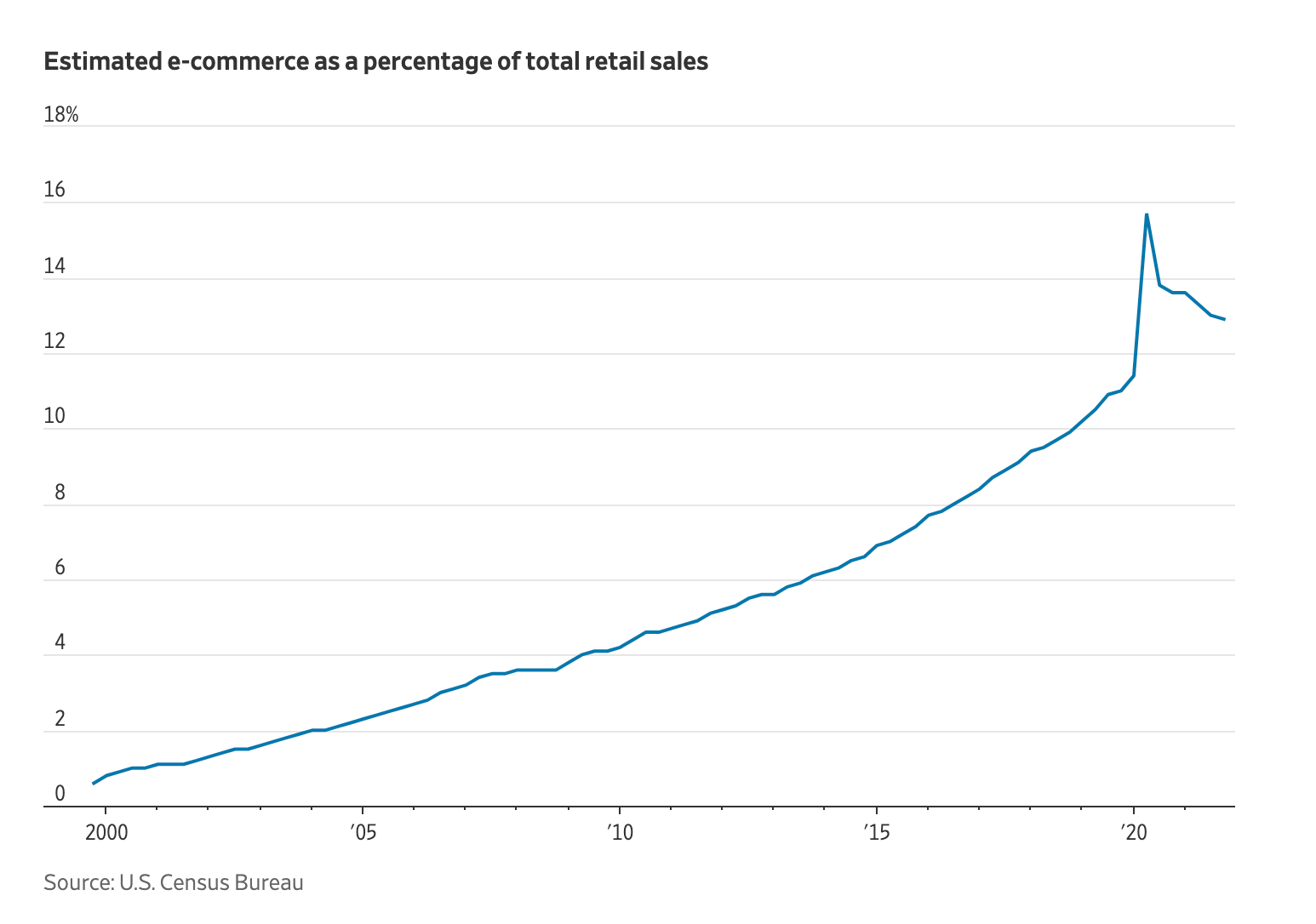As subscriptions falter, commerce could soon follow
As subscriptions falter, commerce could soon followPublishers relying on affiliate revenue could soon feel the pinchA song to read by: “The Tide is High,” by Blondie What I’m reading: “The Internet Is Not What You Think It Is,” by Justin E. H. Smith Although I generally consider myself the caretaker type, when it comes to the task of separating ideological babies from their ideological bathwater, I must admit that I quite enjoy throwing them out together. That is why, given the mounting evidence that consumers are abandoning many of the purchasing behaviors they adopted over the last two years, I say: Why stop there? What other trends, born in the last two years, might we soon walk back? Indeed, a growing body of evidence suggests that the economy the pandemic wrought was, rather than a glimpse into the future, simply a makeshift survival mechanism. The digital subscription boom that launched a thousand newsletters appears to be cresting — across the media ecosystem, publishers are putting their paywalls under the microscope or abandoning them altogether. Streamers that saw two years of uninterrupted growth have run into a wall. Conversely, digital advertising, the yin to reader revenue yang, has returned triumphant. In the last twelve months, much of the digital media ecosystem has seen windfall advertising revenues — Jacob Donnelly has called it the “pivot to advertising.” And now, following on the heels of these two pandemic turnarounds, the third horse of the economic apocalypse appears poised to whinny. Ecommerce — or, as we call it in the business, “commerce” — has recently shown signs of returning to earth after two years of unsustainable growth. During the height of the pandemic, consumers, armed with stimulus checks, festooned at home and bored out of their gourds, spent money online like the economy depended on it. At the height of this trend, in the second quarter of 2020, 15.7% of commerce occurred via the web, according to The Wall Street Journal. Now, a variety of factors have led that growth to slow: In the fourth quarter of 2021, the percentage of commerce occurring on the web dropped to 11.9%. For one, obviously, people have resumed shopping in-person. I know I, for one, simply cannot help but peruse the Banana Republic at Grand Central Station every time I pass. On top of that, a variety of digital privacy measures, most notably the App Transparency Tracking update issued by Apple last July, have effectively knee-capped Facebook, scrambling the marketing plans of direct-to-consumer businesses across the internet. In the U.S., the cost to reach 1,000 people on Facebook jumped from $6 to as much as $18 within the past two years, per CNBC. This pivot to privacy, combined with the general castoff of third-party cookies, has thrown a serious wrench in the hockey stick dreams of ecommerce companies like Warby Parker, Stitch Fix, Allbirds and even the self-styled arms dealer itself, Shopify. Even Amazon, the figurehead of American consumerism incarnate, has not been immune from the web commerce chill. The company saw its growth rate slow from 44% in the first quarter of the 2021 to 7% in the first quarter of 2022, its slowest first-quarter growth ever. For the most part, these reversals stem from issues related to the supply chain and inflation. No matter how enticingly Netflix combines models, their exes and an island, penny-pinching consumers will always cut entertainment expenses the moment real bills come knocking. With the price of living rising, spending will inevitably plunge across the board. But these changing behaviors also signal a return to pre-pandemic norms. When given the choice between a free, ad-supported product and its gated clone, the majority of consumers — nay, humans! — will choose the former. The pandemic may have interrupted this tendency, but it was never going to change it. So, given that consumers seem intent on resuming other traditional behaviors, there is good reason to believe that commerce might follow a similar trend. Could it be that people simply enjoy buying certain items in person, even when given the ability to do so online? The folks in Silicon Valley might find this particular preference vexing, but it does track with several millennia of human existence. Unfortunately for publishers, much like those that spent the last two years spinning up a subscription program out of thin air, a number of media companies bet heavily on the rising tide of commerce. A few, including BuzzFeed, BDG and Future come first to mind, but nearly every major media company took the opportunity to dust off its old product recommendation program in hopes of stumbling into a fortune. And why not? Every economic trend since 2020 has pointed to online commerce as the future of retail, and data backed the claims. But now these surefire projections have grown complicated, and publishers that built businesses on the backs of them could end up overextended, waiting on outsized commerce revenues that were only the product of pandemic-era habits. BuzzFeed, famously, predicted that nearly a third of its revenue might come from commerce by 2024. But in the fourth quarter of 2021, its first as a public company, commerce revenues declined 26%, to $16.7 million. (Annually, commerce grew 19%.) With Facebook, Shopify and Amazon all posting deflated commerce numbers, how could publishers hope to prove the exception? Indeed, a confluence of malicious market forces seem to conspired to sour one of the few bright spots for media companies, proving yet again that the industry is truly without favor in the eyes of the lord. What is there to do? Luckily, the high tide of rising advertising revenues could carry the industry in the short term. And in the future? Publishers will have to do what they always do — find another way to survive. Some Good Readin’— A bit of a wonky dive, by moi, into how Condé Nast turned its first profit in years. (Adweek) — And the big acquisition last week, by G/O Media of Quartz, broken down a bit further. (Adweek) — The most in-the-weeds ad tech newsletter, which I subscribed to a month ago and have found incredibly easy to understand, given the topic. (AdProfs) — A new media newsletter from Daily Beast that veers more gossipy than I normally love, but I can’t resist the signature Beast voice. (Daily Beast) — I’m all for reexamining your relationship to drink and drug, but this article examines the ties between the newly ascendant sober culture and the American tendency toward optimization in all things. (Damage Magazine) — If you haven’t read The Times’ three-part investigation into Tucker Carlson, set some time aside and start here. (The New York Times) — Wonky ad-tech article again, but given that you just read (or skimmed through) an article about commerce, this might be of value to you. (AdExchanger) Cover image: "Landschaft mit grünem Haus,” by Wassily Kandinsky |
Older messages
Nuance is coming to a paywall near you
Thursday, April 28, 2022
Publishers are getting more sophisticated in how they gate their content
For publishers, Netflix is a warning
Thursday, April 21, 2022
Digital subscriptions could soon decline. Medialyte For publishers, Netflix is a warning By Mark Stenberg – 21 Apr 2022 – View online → A song to read by: "Á l'Amour Comme á la Guerre,"
Chasing paper: How the rising price of newsprint threatens the industry
Thursday, March 31, 2022
Print might be shrinking, but publishers still rely heavily on its ad revenue. Medialyte Chasing paper: How the rising price of newsprint threatens the industry By Mark Stenberg – 31 Mar 2022 – View
After wandering the desert, some publishers have found the digital promised land
Thursday, March 3, 2022
A years-ago gamble on the future of advertising is starting to pay off. Medialyte After wandering the desert, some publishers have found the digital promised land By Mark Stenberg – 03 Mar 2022 – View
What are the ‘dark patterns’ of the media industry?
Thursday, February 17, 2022
What publishers could learn from a new ruling on consent buttons. Medialyte What are the 'dark patterns' of the media industry? By Mark Stenberg – 17 Feb 2022 – View online → A song to read by:
You Might Also Like
Never mind the ballots
Friday, November 22, 2024
The future for prediction markets is… unpredictable ͏ ͏ ͏ ͏ ͏ ͏ ͏ ͏ ͏ ͏ ͏ ͏ ͏ ͏ ͏ ͏ ͏ ͏ ͏ ͏ ͏ ͏ ͏ ͏ ͏ ͏ ͏ ͏ ͏ ͏ ͏ ͏ ͏ ͏ ͏ ͏ ͏ ͏ ͏ ͏ ͏ ͏ ͏ ͏ ͏ ͏ ͏ ͏ ͏ ͏ ͏ ͏ ͏ ͏ ͏ ͏ ͏ ͏ ͏ ͏ ͏ ͏ ͏ ͏ ͏ ͏ ͏ ͏ ͏ ͏ ͏ ͏ ͏ ͏ ͏
10-second trick
Friday, November 22, 2024
Every year we bring the highest quality software to RocketHub for an insane BFCM event. This year is no different! BFCM starts now so check the page below for one new lifetime deeaaal drop each day.
🔍 How James Clear Manufactured Word Of Mouth To Create A NYT’s #1 Best Seller
Friday, November 22, 2024
November 21, 2024 | Read Online All Case Studies 🔍 Learn About Sponsorships It's true - nothing is more powerful than word of mouth. But here's what they don't tell you - you can
🚀 The Black Friday Sale is LIVE - Act Now!
Friday, November 22, 2024
View in browser ClickBank Black Friday Starts Today Hey there, ClickBanker! The wait is over! Here's what you've been waiting for - our Black Friday specials are out of this world and now LIVE!
The haka heard around the world
Friday, November 22, 2024
Weekender #50 ͏ ͏ ͏ ͏ ͏ ͏ ͏ ͏ ͏ ͏ ͏ ͏ ͏ ͏ ͏ ͏ ͏ ͏ ͏ ͏ ͏ ͏ ͏ ͏ ͏ ͏ ͏ ͏ ͏ ͏ ͏ ͏ ͏ ͏ ͏ ͏ ͏ ͏ ͏ ͏ ͏ ͏ ͏ ͏ ͏ ͏ ͏ ͏ ͏ ͏ ͏ ͏ ͏ ͏ ͏ ͏ ͏ ͏ ͏ ͏ ͏ ͏ ͏ ͏ ͏ ͏ ͏ ͏ ͏ ͏ ͏ ͏ ͏ ͏ ͏ ͏ ͏ ͏ ͏ ͏ ͏ ͏ ͏ ͏ ͏ ͏ ͏ ͏ ͏ ͏ ͏ ͏ ͏ ͏
Weird trick results in 14.1 million monthly visitors
Thursday, November 21, 2024
I was SHOCKED
How to improve the observability and reliability of your AI cluster [💡Webinar ]
Thursday, November 21, 2024
November 21, 2024 | Read Online How to improve the observability and reliability of your AI cluster [💡Webinar ] There are so many challenges when it comes to maintaining large AI clusters. We recommend
Podcast app setup
Thursday, November 21, 2024
Open this on your phone and click the button below: Add to podcast app
On The (Product) Hunt!
Thursday, November 21, 2024
Some News On My End
Highlight your social media ROI to execs
Thursday, November 21, 2024
Use these free templates to tell the story ͏ ͏ ͏ ͏ ͏ ͏ ͏ ͏ ͏ ͏ ͏ ͏ ͏ ͏ ͏ ͏ ͏ ͏ ͏ ͏ ͏ ͏ ͏ ͏ ͏ ͏ ͏ ͏ ͏ ͏ ͏ ͏ ͏ ͏ ͏ ͏ ͏ ͏ ͏ ͏ ͏ ͏ ͏ ͏ ͏ ͏ ͏ ͏ ͏ ͏ ͏ ͏ ͏ ͏ ͏ ͏ ͏ ͏ ͏ ͏ ͏ ͏ ͏ ͏ ͏ ͏ ͏ ͏ ͏ ͏ ͏ ͏ ͏ ͏ ͏ ͏ ͏ ͏ ͏

